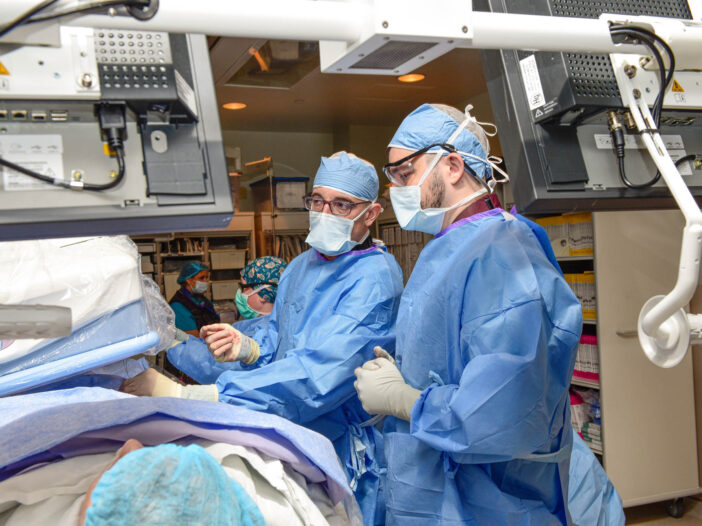
Cardiothoracic surgery involves the organs in the thoracic cavity or chest – most often, the heart and lungs. At Central Maine Heart and Vascular Institute (CMHVI), we know that having cardiothoracic surgery can be worrying. But we work closely with you to make sure you fully understand your surgery and are as comfortable as possible before, during and after your operation takes place.
We provide you with the best cardiothoracic technology and resources available. Our “smart” cardiothoracic operating rooms include special cabling, data connections, light booms and display screens that can be upgraded to accommodate emerging technologies, including voice recognition and robotics.
Get Blood Flowing Again with Coronary Artery Bypass Graft (CABG) Surgery
If you have one or more blocked coronary arteries, your heart may not be getting enough of the blood and oxygen it needs. Bypass surgery can create new pathways for blood to reach your heart. Also known as coronary artery bypass graft, or CABG (pronounced “cabbage”), bypass surgery is open-heart surgery that requires general anesthesia.
During conventional bypass surgery, which is done through an incision in your breastbone (sternum), your surgical team stops your heart with medication and uses a heart-lung machine to oxygenate and circulate your blood. Your surgeon removes a piece of a healthy blood vessel from your leg, arm or chest wall to use as a graft to create a new path for blood flow around a blocked artery. One end of the healthy graft is sewn to the blood vessel just below the blocked artery. The other end is sewn above the blocked artery. Blood can then flow around the blocked area, allowing your blood to move more freely through your coronary arteries, lowering the risk of heart attack.
Heart Valve Replacement and Repair
If you have a diseased heart valve, your cardiologist may recommend heart valve replacement or repair. During valve surgery, your surgical team stops your heart with medication and uses a heart-lung machine to oxygenate and circulate your blood. Your surgeon removes the damaged valve and sews a new valve in place. The replacement valve may come from an organ donor, but it is more likely to be a mechanical valve made of plastic and metal. Sometimes diseased valves can be repaired – for example, if calcium deposits on the valve can be removed, the valve may be surgically reshaped, allowing it to close more effectively. If the valve opening is too big, it sometimes can be tightened with stitches.
Esophagectomy
An esophagectomy is a surgical procedure where your esophagus – the tubular structure connecting the mouth and stomach – is partially or completely removed and replaced with a portion of your stomach or colon. The procedure may be necessary due to cancer, trauma, ingestion of caustic substances or spontaneous rupture of the esophagus (usually due to severe vomiting). In some instances, the surgery can be performed in a minimally invasive or laparoscopic/thoracoscopic procedure.
Other Thoracic and Lung Surgery
We offer a range of other thoracic and lung surgical procedures as well. We work closely with pulmonologists, gastroenterologists, oncologists and primary care providers in the region. Among the procedures we provide are:
- Pulmonary resection: Removal of part of the lung
- Mediastinal tumors: Removal of thymoma, teratoma, nerve tumors
- Tracheal and bronchial surgery: Removal of part of the trachea or bronchus
- Video assisted thoracic surgery (VATS): Also known as endoscopic thoracic surgery or minimally invasive thoracic surgery (thoracoscopy)
Many thoracic surgical procedures are performed using small incisions and advanced video-assisted techniques, which reduces post-operative discomfort, decreases length of hospitalization and returns people to normal activities sooner. Medical issues often treated using these techniques are:
- Pleural effusion: Fluid around the lungs or lung biopsy (disease diagnosis)
- Lobectomy for cancer of the lung: Early lung cancers can often be removed using minimally invasive techniques
- Mediastinal tumors: Some tumors and cysts can be removed endoscopically
- Pneumothorax (lung collapse): Removal of the leaky area of the lung. (Pleurodesis, a procedure that uses medications to seal your lung to your chest wall, can usually be done endoscopically.)
- Hyperhidrosis treatment: Stops excessive sweating, by removing part of the sympathetic nerve system. This procedure is also effective for patients with other upper extremity problems, including reflex sympathetic dystrophy and Raynaud’s disease.
